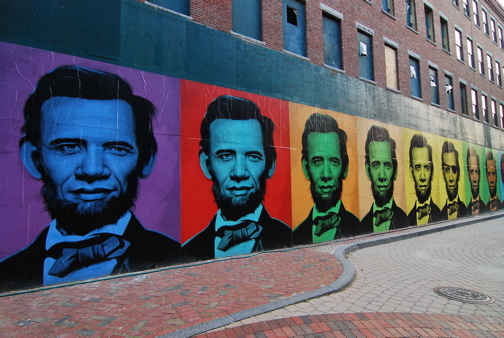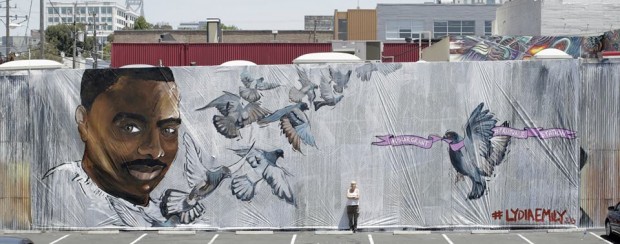
“The true mystery of the world is the visible, not the invisible.”


“The true mystery of the world is the visible, not the invisible.”
Saul Bass (1920-1996) created an entire film genre. Bass started his career as a graphic designer who filled the American landscape with such designs as Exxon service stations and the jars for Lawry’s seasonings. But it was in film where he made his most lasting impact, as the man who invented the opening credit sequence as a free-standing movie-before-a-movie and elevated it into an art.

Movies have always had opening credits, but until The Man With the Golden Arm, in 1955, they were rarely more creative than having the names of the movie’s stars and production staff revealed by the turning pages of a book. However, Bass revolutionized the form when he created an innovative title sequence with a grotesquely deconstructed arm symbolizing heroin addiction for Preminger’s movie.
He designed the deconstructed body for Anatomy of a Murder; had an aerial camera swoop across Manhattan before zooming in on a schoolyard at the beginning of West Side Story, and set a black cat walking through the titles of Walk on the Wild Side. In what was perhaps his most daring innovation in opening credits, Bass created a reprise of the story of Around the World in 80 Days in a 20-minute sequence that did not run until after the movie.
Together with his wife, Elaine Bass, he made a series of acclaimed short movies, among them From Here to There (1964) and Why Man Creates, which won an Academy Award for documentary short subject in 1968.
Bass, also did the titles for Alfred Hitchcock’s Vertigo and North by Northwest, but did even more for Psycho. The director had become so impressed with Bass’s work that he included him in the planning of the infamous 70-shot shower sequence within the film. The same year he also helped Stanley Kubrick design the final battle scene in Spartacus.
The American avant garde composer George Antheil, the Bad Boy of Music, (the title of his 1945 autobiography), is best known for a piece he wrote in Paris in his mid-20s, “Ballet Mécanique.” The work was originally conceived as a twenty five minute score to accompany a Dadaist silent film by Fernand Léger and Dudley Murphy. The piece was intended to be performed by sixteen synchronized player pianos, but Antheil could never figure out how to get the pianos to play in sync. Together with the actress Hedy Lamarr, best known as a screen goddess of the late-1930s and ’40s. submitted an idea of a secret communication system to the U.S. patent office in June 1941

On August 11, 1942, U.S. Patent 2,292,387 was granted to Antheil and “Hedy Kiesler Markey”, Lamarr’s married name at the time. This early version of frequency hopping used a piano roll to change between 88 frequencies and was intended to make radio-guided torpedoes harder for enemies to detect or jam. The idea was not implemented until 1962, when it was used by U.S. military ships during the blockade of Cuba after the patent had expired.
Lamarr’s and Antheil’s frequency-hopping idea serves as a basis for modern spread-spectrum communication technology, such as Bluetooth, COFDM used in Wi-Fi network connections, and CDMA used in some cordless and wireless telephones.
Korean archaeologists dug into the tomb
broke through a hardened-earth shell
and exposed the wooden coffin
Inside
a 16th century male mummy
tall, even by today’s standards
measuring 5 feet 9 inches
and sturdily built.
resting across his body
was the following letter…
To Won’s Father
June 1, 1586You always said, “Dear, let’s live together until our hair turns gray and die on the same day. How could you pass away without me? Who should I and our little boy listen to and how should we live? How could you go ahead of me?
How did you bring your heart to me and how did I bring my heart to you? Whenever we lay down together you always told me, “Dear, do other people cherish and love each other like we do? Are they really like us?” How could you leave all that behind and go ahead of me?
I just cannot live without you. I just want to go to you. Please take me to where you are. My feelings toward you I cannot forget in this world and my sorrow knows no limit. Where would I put my heart in now and how can I live with the child missing you?
Please look at this letter and tell me in detail in my dreams. Because I want to listen to your saying in detail in my dreams I write this letter and put it in. Look closely and talk to me.
When I give birth to the child in me, who should it call father? Can anyone fathom how I feel? There is no tragedy like this under the sky.
You are just in another place, and not in such a deep grief as I am. There is no limit and end [to my sorrows] that I write roughly. Please look closely at this letter and come to me in my dreams and show yourself in detail and tell me. I believe I can see you in my dreams. Come to me secretly and show yourself. There is no limit to what I want to say and I stop here.

Youssef Abdelke, an internationally acclaimed Syrian artist and a communist activist from the Christian community, spent the best part of 1978 to 1980 incarcerated. Following this he went into a self-imposed exile in Paris, until he returned to Syria in 2005, where he has been relating the tragedy of what is happening in Syria through his work.
The artist and dissident had just signed a petition started by Syrian academics and artists calling for a peaceful and political solution to the conflict in the country that has now gone on for over two years. The document demands the ouster of Bashar al-Assad and a transition to a democratic system with an interim government under UN supervision. Unfortunately, Abdelke was arrested last Thursday (July 19th) by Assad forces at a security checkpoint in the port city of Tartus.

Over the last few years Syria has seen an increase in the targeting of intellectuals and artists: from the cartoonist Ali Ferzat who was arrested and had his hands broken, to ‘The Singer of the Revolution’, Ibrahim Kashoush, who had his throat cut.
There is currently a Facebook campaign, launched in Syria, calling for the release of Youssef Abdelke.
To promote the upcoming movie “Fruitvale Station,” about the 2009 fatal shooting of an unarmed Oscar Grant by a Bart police officer on a platform at Oakland’s Fruitvale BART Station, the Weinstein Company. commissioned three murals in Los Angeles, New York and San Francisco by street artists Ron English, Lydia Emily and LNY. Unfortunatley, logistical issues and creative conflicts between some of the artists and the studio have led to delays and disagreements.
Ron English’s work on the Los Angeles mural was supposed to begin June 27th, but production stopped that morning. For this mural Grant’s face was to be seen over a rainbow-colored backdrop, not unlike the “Abraham Obama” image English created for the 2008 presidential election.

Ron English, “Abraham Obama”
English’s first choice, however, was a version of a Norman Rockwell painting, in which he depicted an African American boy with a target on his back. He was told, however, that the image was “too aggressive.” “It’s been pretty frustrating,” English told the Los Angeles Times. “They rejected my first idea. The next one we changed about eight times and the director got involved and rejected it. The director said it can’t be anything negative or about the police or guns.”

Lydia Emily, “Oscar Grant”
Los Angeles. artist Lydia Emily was originally to paint the San Francisco wall with Oakland-based street artist Eddie Colla. After creative differences, however, Colla left the project. Emily painted the San Francisco mural solo on the side of Ian Ross Gallery, south of Market Street. LNY is set to begin work on her mural in Williamsburg, Brooklyn, once unspecified “logistical issues” are settled.
“Fruitvale” took home both the Audience Award and the Grand Jury Prize at last January’s Sundance Film Festival.